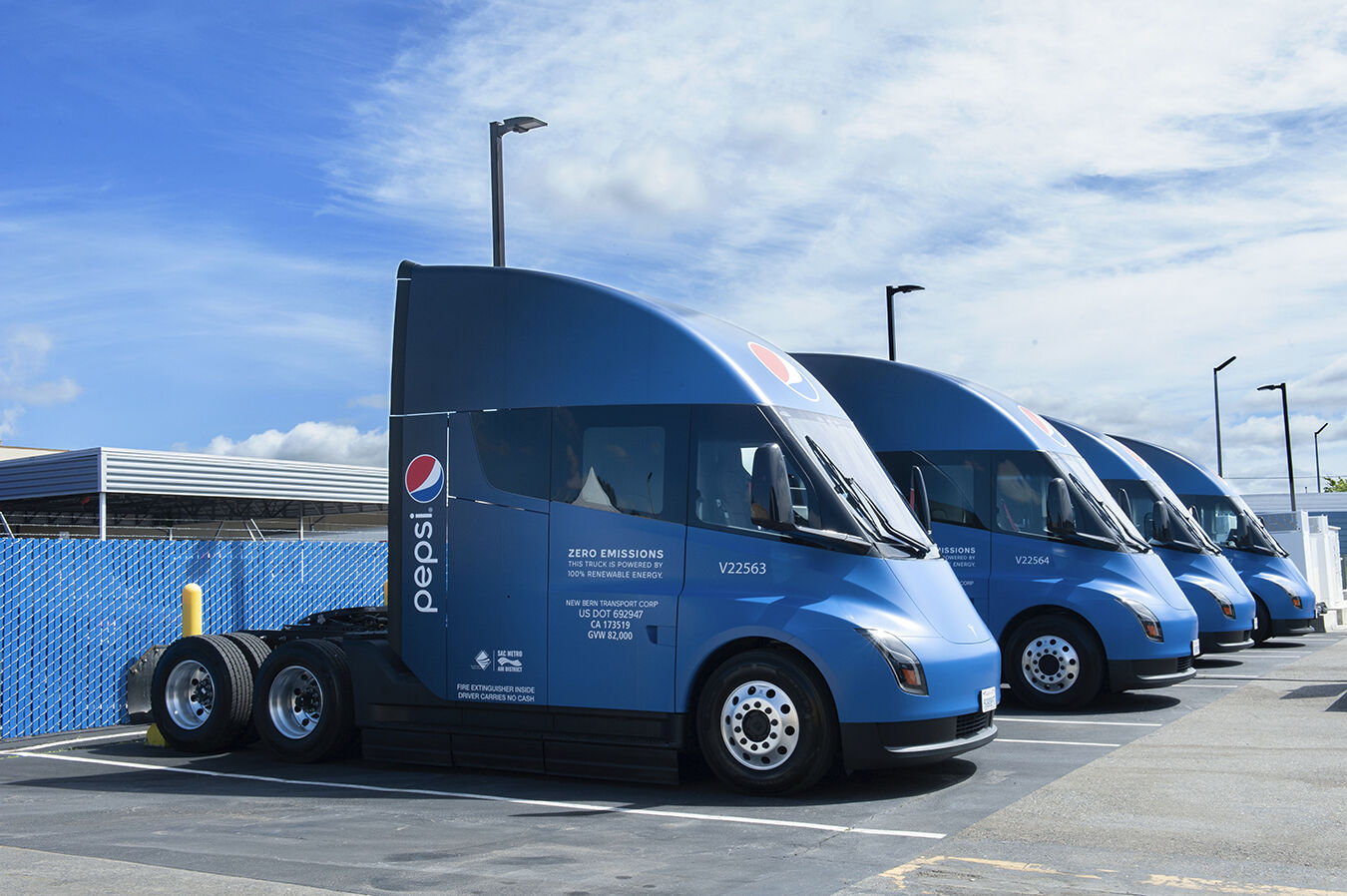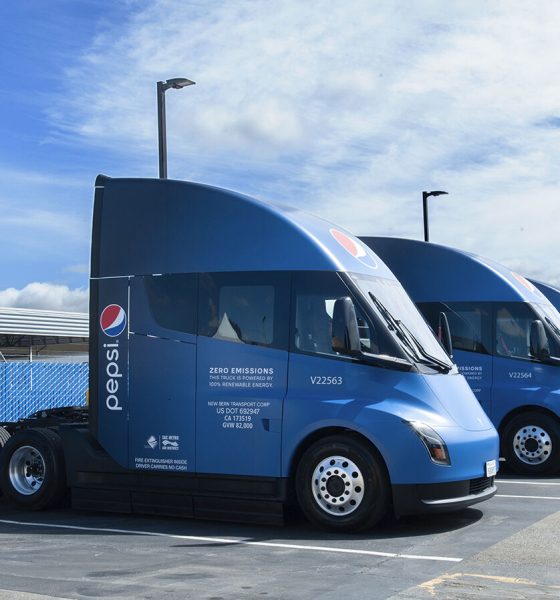

News
Tesla Semi real-world sightings show that a cleaner, quieter future is possible for the trucking sector
The Tesla Semi may still be in its initial production, but the units that have been delivered to PepsiCo are already making a strong statement. If anything, they emphasize the idea that it is possible to adopt a cleaner, quieter alternative to conventional trucking solutions featuring large, noisy, Class 8 diesel-powered semitrailers today.
It is easy to forget that while diesel-powered trucks have been the norm for a very long time, they do come with their own set of inconveniences. In 2021, researchers from the University of Michigan highlighted the issue of noise and air pollution caused by heavy-duty diesel trucks running through neighborhoods in Southwest Detroit. Residents in affected neighborhoods told the media that the presence of large diesel trucks is challenging because they tend to be noisy, and their emissions are significant. Some residents also noted that the constant sound from the diesel trucks had become a stressor.
Such issues are directly addressed by vehicles like the Tesla Semi. Being all-electric, the Semi is arguably the quietest Class 8 truck on the road today, with most of the vehicle’s sound seemingly coming from its wheels. The absence of an exhaust pipe on the Tesla Semi also means that regardless of where the Semi travels, people around it would not need to worry about inhaling harmful substances.
Needless to say, the Tesla Semi is a glimpse of a cleaner, quieter future for the trucking sector. And thanks to the growing number of PepsiCo’s Tesla Semi fleet, the EV community can now get a glimpse of what an electric truck-powered future could be like. Social media posts featuring the Class 8 all-electric truck in action show that the Semi is indeed a very quiet vehicle, and unlike its diesel-powered counterparts, it would likely not be as much of a nuisance for residents even if it travels through inner-city streets.
The lack of noise and emissions from the Tesla Semi is only the tip of the iceberg for the Class 8 all-electric truck’s inherent advantages. The vehicle is equipped with numerous safety features and driver-centric functions that would likely make the Tesla Semi a great truck to drive, even for drivers who have spent decades operating a conventional diesel semitrailer. Of course, both drivers and operators have to be open-minded enough to try out the Tesla Semi before the vehicle can truly make a difference.
Considering the initial reception of the Semi from PepsiCo and the general public so far, it appears that the enthusiasm surrounding all-electric Class 8 trucks is substantial. This is good news overall. As noted by CEO Elon Musk during the Semi’s first delivery event, after all, trucks comprise just 1% of all vehicles on US roads, but they are responsible for 20% of all US vehicle emissions and 36% of all US vehicle particulate emissions. It is then in everyone’s best interest to change the status quo.
Don’t hesitate to contact us with news tips. Just send a message to simon@teslarati.com to give us a heads up.

News
Tesla FSD fleet is nearing 7 billion total miles, including 2.5 billion city miles
As can be seen on Tesla’s official FSD webpage, vehicles equipped with the system have now navigated over 6.99 billion miles.

Tesla’s Full Self-Driving (Supervised) fleet is closing in on almost 7 billion total miles driven, as per data posted by the company on its official FSD webpage.
These figures hint at the massive scale of data fueling Tesla’s rapid FSD improvements, which have been quite notable as of late.
FSD mileage milestones
As can be seen on Tesla’s official FSD webpage, vehicles equipped with the system have now navigated over 6.99 billion miles. Tesla owner and avid FSD tester Whole Mars Catalog also shared a screenshot indicating that from the nearly 7 billion miles traveled by the FSD fleet, more than 2.5 billion miles were driven inside cities.
City miles are particularly valuable for complex urban scenarios like unprotected turns, pedestrian interactions, and traffic lights. This is also the difference-maker for FSD, as only complex solutions, such as Waymo’s self-driving taxis, operate similarly on inner-city streets. And even then, incidents such as the San Francisco blackouts have proven challenging for sensor-rich vehicles like Waymos.
Tesla’s data edge
Tesla has a number of advantages in the autonomous vehicle sector, one of which is the size of its fleet and the number of vehicles training FSD on real-world roads. Tesla’s nearly 7 billion FSD miles then allow the company to roll out updates that make its vehicles behave like they are being driven by experienced drivers, even if they are operating on their own.
So notable are Tesla’s improvements to FSD that NVIDIA Director of Robotics Jim Fan, after experiencing FSD v14, noted that the system is the first AI that passes what he described as a “Physical Turing Test.”
“Despite knowing exactly how robot learning works, I still find it magical watching the steering wheel turn by itself. First it feels surreal, next it becomes routine. Then, like the smartphone, taking it away actively hurts. This is how humanity gets rewired and glued to god-like technologies,” Fan wrote in a post on X.
News
Tesla starts showing how FSD will change lives in Europe
Local officials tested the system on narrow country roads and were impressed by FSD’s smooth, human-like driving, with some calling the service a game-changer for everyday life in areas that are far from urban centers.

Tesla has launched Europe’s first public shuttle service using Full Self-Driving (Supervised) in the rural Eifelkreis Bitburg-Prüm region of Germany, demonstrating how the technology can restore independence and mobility for people who struggle with limited transport options.
Local officials tested the system on narrow country roads and were impressed by FSD’s smooth, human-like driving, with some calling the service a game-changer for everyday life in areas that are far from urban centers.
Officials see real impact on rural residents
Arzfeld Mayor Johannes Kuhl and District Administrator Andreas Kruppert personally tested the Tesla shuttle service. This allowed them to see just how well FSD navigated winding lanes and rural roads confidently. Kruppert said, “Autonomous driving sounds like science fiction to many, but we simply see here that it works totally well in rural regions too.” Kuhl, for his part, also noted that FSD “feels like a very experienced driver.”
The pilot complements the area’s “Citizen Bus” program, which provides on-demand rides for elderly residents who can no longer drive themselves. Tesla Europe shared a video of a demonstration of the service, highlighting how FSD gives people their freedom back, even in places where public transport is not as prevalent.
What the Ministry for Economic Affairs and Transport says
Rhineland-Palatinate’s Minister Daniela Schmitt supported the project, praising the collaboration that made this “first of its kind in Europe” possible. As per the ministry, the rural rollout for the service shows FSD’s potential beyond major cities, and it delivers tangible benefits like grocery runs, doctor visits, and social connections for isolated residents.
“Reliable and flexible mobility is especially vital in rural areas. With the launch of a shuttle service using self-driving vehicles (FSD supervised) by Tesla in the Eifelkreis Bitburg-Prüm, an innovative pilot project is now getting underway that complements local community bus services. It is the first project of its kind in Europe.
“The result is a real gain for rural mobility: greater accessibility, more flexibility and tangible benefits for everyday life. A strong signal for innovation, cooperation and future-oriented mobility beyond urban centers,” the ministry wrote in a LinkedIn post.
News
Tesla China quietly posts Robotaxi-related job listing
Tesla China is currently seeking a Low Voltage Electrical Engineer to work on circuit board design for the company’s autonomous vehicles.

Tesla has posted a new job listing in Shanghai explicitly tied to its Robotaxi program, fueling speculation that the company is preparing to launch its dedicated autonomous ride-hailing service in China.
As noted in the listing, Tesla China is currently seeking a Low Voltage Electrical Engineer to work on circuit board design for the company’s autonomous vehicles.
Robotaxi-specific role
The listing, which was shared on social media platform X by industry watcher @tslaming, suggested that Tesla China is looking to fill the role urgently. The job listing itself specifically mentions that the person hired for the role will be working on the Low Voltage Hardware team, which would design the circuit boards that would serve as the nervous system of the Robotaxi.
Key tasks for the role, as indicated in the job listing, include collaboration with PCB layout, firmware, mechanical, program management, and validation teams, among other responsibilities. The role is based in Shanghai.
China Robotaxi launch
China represents a massive potential market for robotaxis, with its dense urban centers and supportive policies in select cities. Tesla has limited permission to roll out FSD in the country, though despite this, its vehicles have been hailed as among the best in the market when it comes to autonomous features. So far, at least, it appears that China supports Tesla’s FSD and Robotaxi rollout.
This was hinted at in November, when Tesla brought the Cybercab to the 8th China International Import Expo (CIIE) in Shanghai, marking the first time that the autonomous two-seater was brought to the Asia-Pacific region. The vehicle, despite not having a release date in China, received a significant amount of interest among the event’s attendees.








